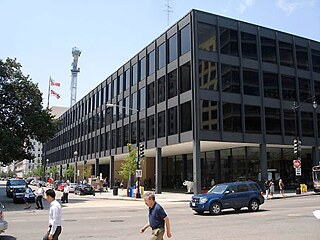Martin Luther King Memorial Library
German Roots in DC
-

Martin Luther King Library, August 2010.
-

Original model of the Martin Luther King Library, on display in the Washingtoniana Collection.
In addition to its collection of books and audio-visual materials, the library is home to the Washingtoniana Collection, an excellent source of books, photographs, and other materials related to DC history. A major highlight is the Washington Star collection of photographs and files from the former newspaper, which stopped publishing in 1981.
In 2004, the DC Preservation League put the library on its "Watch List," consisting of "sites that [the League] feels are not in imminent danger, but deserve regular scrutiny because of potential future threats to their integrity." In the case of the MLK Library, the League notes "a lack of preventive maintenance and system upgrades" over the last three decades, adding further that "the District government's plans for the library are uncertain."
Ludwig Mies van der Rohe, Architect
Born in Aachen, Germany in 1886, Ludwig Mies van der Rohe worked in the family stone-carving business before he started his career as an architect, mostly at the studio and under the influence of Peter Behrens. Mies, as he was known to his friends, quickly identified himself with Russian Constructivism and the Dutch De Stijl group. He took his own first steps in a modern direction with his presentation of the faceted all-glass Friedrichstraße skyscraper model for a 1921 competition in Berlin.A prime example of Mies van der Rohe’s exceptional qualities as an artistic director was the 1927 Weissenhof Project, a model housing colony in Stuttgart comprised of 21 buildings, designed by sixteen European architects.
In 1929, Mies van der Rohe constructed one of his European masterpieces: the temporary German Pavilion for the Barcelona exposition. In the same year, he became the director of the slowly faltering Bauhaus school, at that time located in Dessau. In 1932, the government-financed institution moved to Berlin, where it had to close under ensuing Nazi political pressure.
In 1937, seeing no future for himself in his homeland, Mies moved to Chicago. He wasn’t new to the world of construction in the United States. In 1932, the first architectural exhibition at the MoMA had included several of his projects. Mies van der Rohe became head of the architecture school at Chicago's Armour Institute of Technology and designed a new campus.
His severance from Germany was completed when he decided to become an US citizen in 1944. In his so-called “American Period,” Mies built a number of buildings in locations such as Chicago (including the Crown Hall at the College of Architecture, theFarnsworth House and the Chicago Federal Center), in New York (theSeagram Building), and in Washington (Martin Luther King, Jr. Memorial Library). All these buildings followed his concept of "skin and bones" architecture with minimal framework and free-flowing open space.
Despite all his years spent in the United States, Mies’ career as an architect culminated in his homeland. The Neue Nationalgalerie in Berlin, the New National Gallery, was Mies van der Rohe’s last work. He returned to Berlin several times during the construction, but he was unable to attend the 1968 opening. Ludwig Mies van der Rohe died in Chicago in 1969.